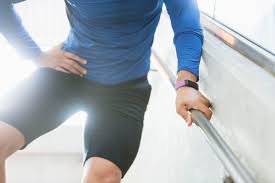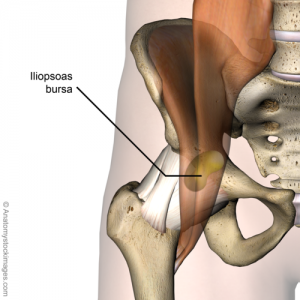Iliopsoas Bursitis

It’s a pain that no one wants to experience. It lives in the front of your hip and groin and can radiate down the inside of the thigh to the knee. The hip and groin pain is noticeable with certain hip motions and activities. It’s called Iliopsoas bursitis, and you might have it.
Iliopsoas bursitis is an inflammatory condition that involves the muscle and bursa in the hip/groin region. It is often the result of repetitive hip flexion (bending) in activities such as running, dancing, track and field and gymnastics. People report having pain in the front of the hip and groin region that often radiates down the front or inner thigh all the way to the knee. Occasionally, a snapping or clicking is heard that may or may not be painful. The pain is made worse with extending the hip back, crossing the leg in front of the body, and twisting the leg inwards. Bringing the knee up to the chest can often produce a pinching sensation in the hip or groin.

The Iliopsoas bursa is the largest bursa of the 160 bursae found in the human body. A bursa is a fluid-filled sac that lies between a muscle and bony prominence. It is designed to reduce the friction and provide cushioning for the muscle as it glides over the bony prominence. Inflammation of the Iliopsoas bursa results when the overlying hip flexor muscle produces excessive pressure or friction on the bursa during movement. This increase in friction is often a result of tight hip flexors combined with repeated hip flexion, poor mechanics, or even direct trauma.
The amount of repeated hip flexion during running, dancing, gymnastics, and field events makes this a familiar condition for these athletes but it is also common among the recreational athlete too. What I tend to see, clinically with the recreational athlete who presents with Iliopsoas bursitis, is someone who typically has a seated job (desk job, driver, etc.) They spend the majority of their day in a seated position, which is the ideal position to promote hip flexor tightness (not to mention hamstring and calf tightness). Then, with their tight hip flexors, they go for a run or a long hike. The whole time the tight hip flexor is gliding over the underlying Iliopsoas bursa, creating excessive friction and inflammation. The end result in both cases is the same. Pain, decreased hip motion, decreased activity tolerance, and often tenderness to touch.

Treatment for Iliopsoas bursitis includes stopping the irritating activity, decreasing the inflammation with ice, using anti-inflammatory medication as directed, and seeing your Osteopath for assessment and treatment. Your Osteopath will determine the cause of the irritation to the bursa, rule out other possible diagnosis, and administer additional inflammatory reduction therapy (ultrasound and electrical stimulation). They will begin stretching exercises as soon as possible, and then appropriate strengthening exercises to minimize reoccurrence. If your injury was a result of improper mechanics, your Osteopath will also be able to help you identify and correct those factors.
Colgan Osteopathy in Kettering Northamptonshire
Colgan Osteopathy in Hatfield, Hertfordshire
To book an appointment, call 07738493974 or book online